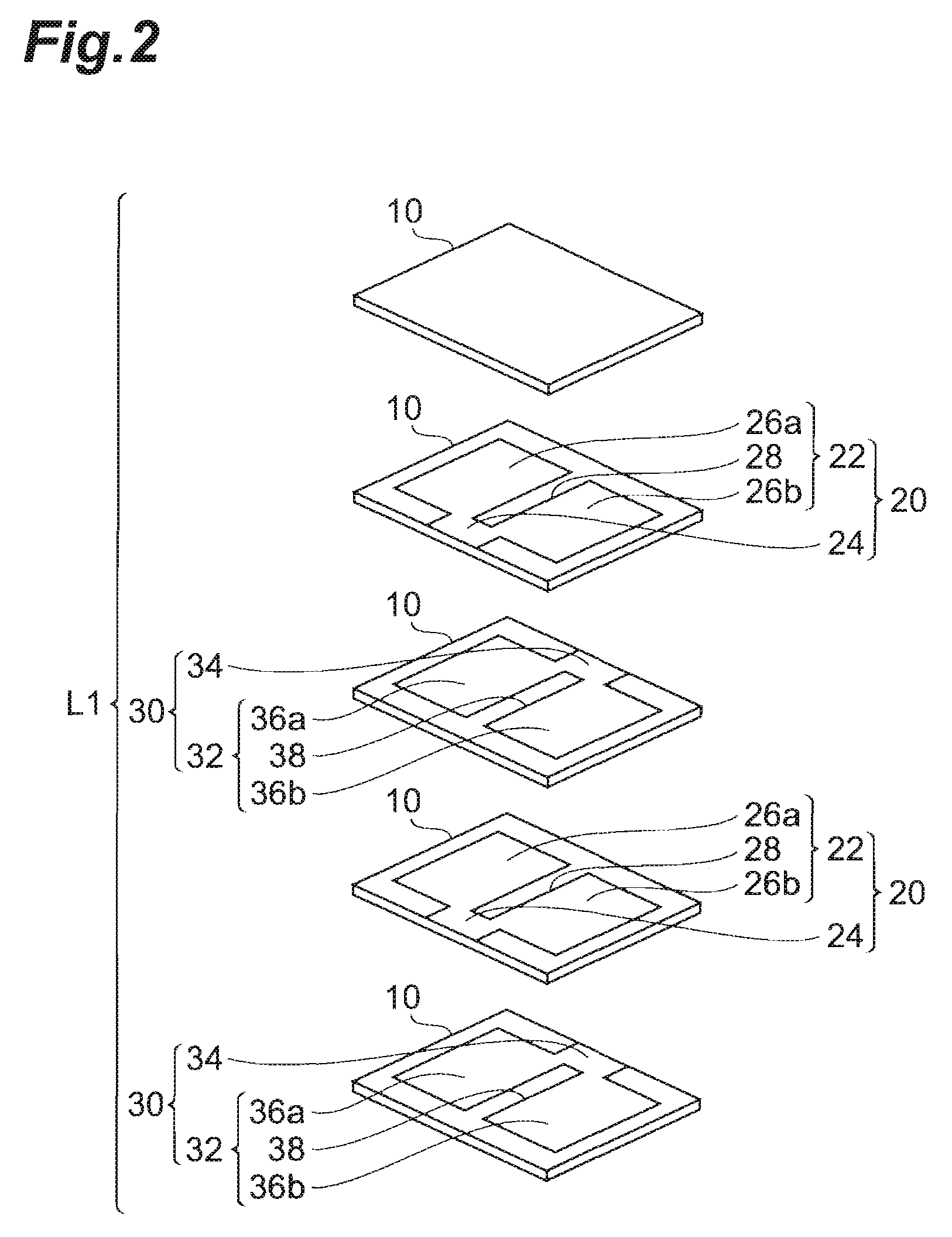Multilayer capacitor
a multi-layer capacitor and capacitor technology, applied in the field of multi-layer capacitors, can solve the problems of vibration in the multi-layer capacitor in particular, mechanical strain proportional to the applied voltage, and mechanical strain that is proportional to the applied voltage, and achieves the effect of mechanical strain
- Summary
- Abstract
- Description
- Claims
- Application Information
AI Technical Summary
Benefits of technology
Problems solved by technology
Method used
Image
Examples
first embodiment
[0031]With reference to FIGS. 1 to 4 and 11, the structure of the multilayer capacitor C1 in accordance with the first embodiment will be explained. FIG. 1 is a perspective view of the multilayer capacitor in accordance with the first embodiment. FIG. 2 is an exploded perspective view of the capacitor body included in the multilayer capacitor in accordance with this embodiment. FIG. 3 is a view for explaining a cross-sectional structure of the multilayer capacitor in accordance with this embodiment. FIG. 4 is a view for explaining a cross-sectional structure of the multilayer capacitor in accordance with this embodiment. FIG. 11 is a view for explaining a cross-sectional structure of the multilayer capacitor in accordance with this embodiment. The cross-sectional hatching is omitted in FIGS. 3 and 4.
[0032]As shown in FIG. 1, the multilayer capacitor C1 comprises a rectangular parallelepiped capacitor body L1, and a first terminal electrode 1 and a second terminal electrode 2 which a...
second embodiment
[0082]With reference to FIG. 5, the multilayer capacitor in accordance with the second embodiment will be explained. The multilayer capacitor in accordance with the second embodiment differs from the multilayer capacitor C1 in accordance with the first embodiment in terms of the form of no-capacity generating regions included in main electrode portions of the first and second inner electrodes. FIG. 5 is an exploded perspective view of the capacitor body included in the multilayer capacitor in accordance with the second embodiment.
[0083]Though not depicted, the multilayer capacitor in accordance with the second embodiment comprises a capacitor body L1, a first terminal electrode 1, and a second terminal electrode 2 as with the multilayer capacitor C1 in accordance with the first embodiment. As shown in FIG. 5, the capacitor body L1 has a plurality (5 layers in this embodiment) of dielectric layers 10, a plurality (2 layers in this embodiment) of first inner electrodes 20, and a plura...
third embodiment
[0131]With reference to FIGS. 7 to 10, the structure of the multilayer capacitor C2 in accordance with the third embodiment will be explained. FIG. 7 is a perspective view of the multilayer capacitor in accordance with this embodiment. FIG. 8 is an exploded perspective view of the capacitor body included in the multilayer capacitor in accordance with this embodiment. FIG. 9 is a view for explaining a cross-sectional structure of the multilayer capacitor in accordance with this embodiment. FIG. 10 is a view for explaining a cross-sectional structure of the multilayer capacitor in accordance with this embodiment. The cross-sectional hatching is omitted in FIGS. 9 and 10.
[0132]As shown in FIG. 7, the multilayer capacitor C2 comprises a rectangular parallelepiped capacitor body L2, and first terminal electrodes 1A, 1B, 1C, 1D and second terminal electrodes 2A, 2B, 2C, 2D which are arranged on outer surfaces of the capacitor body L2. The capacitor body L2 includes rectangular first and s...
PUM
 Login to View More
Login to View More Abstract
Description
Claims
Application Information
 Login to View More
Login to View More - R&D
- Intellectual Property
- Life Sciences
- Materials
- Tech Scout
- Unparalleled Data Quality
- Higher Quality Content
- 60% Fewer Hallucinations
Browse by: Latest US Patents, China's latest patents, Technical Efficacy Thesaurus, Application Domain, Technology Topic, Popular Technical Reports.
© 2025 PatSnap. All rights reserved.Legal|Privacy policy|Modern Slavery Act Transparency Statement|Sitemap|About US| Contact US: help@patsnap.com



